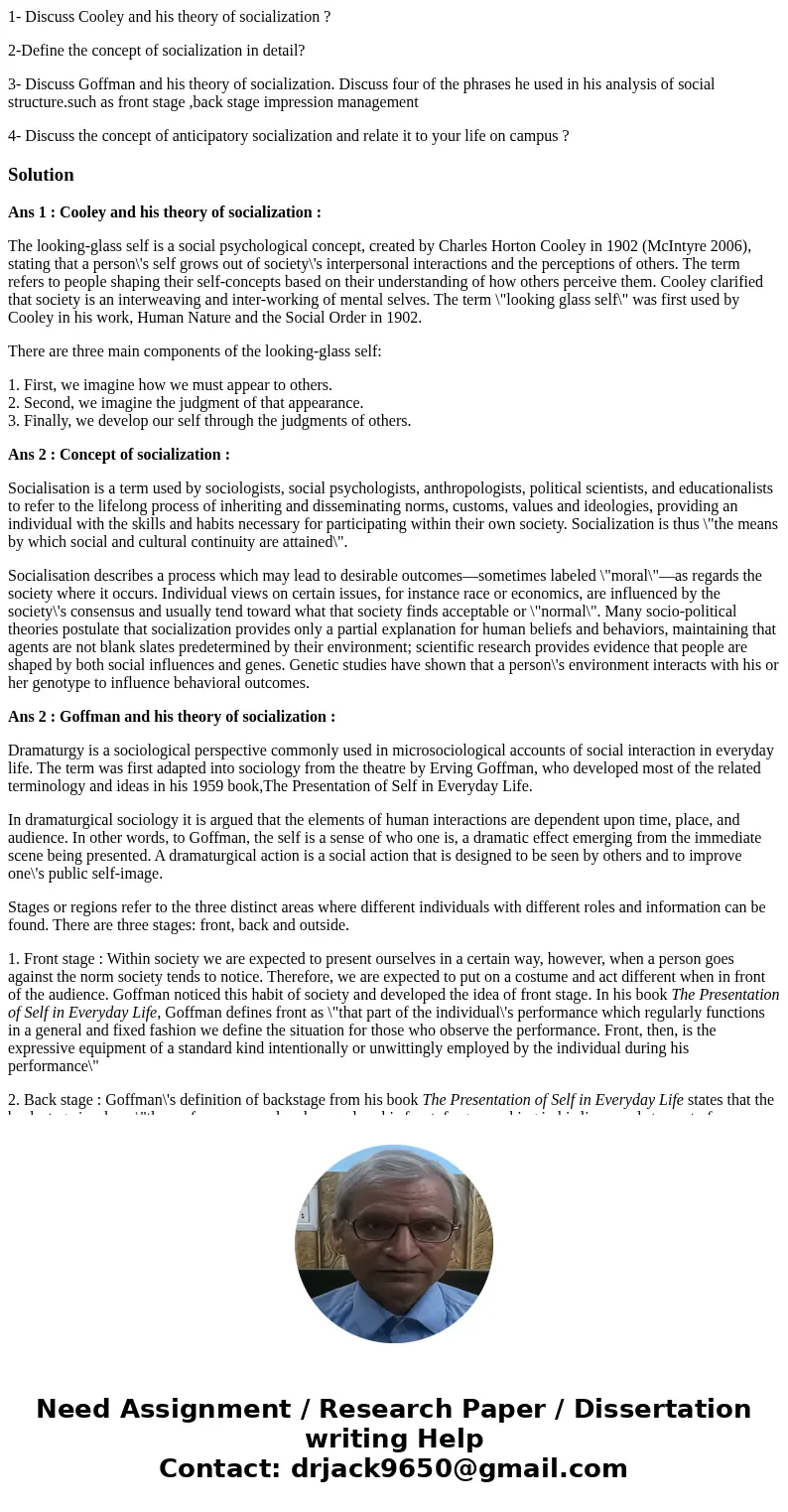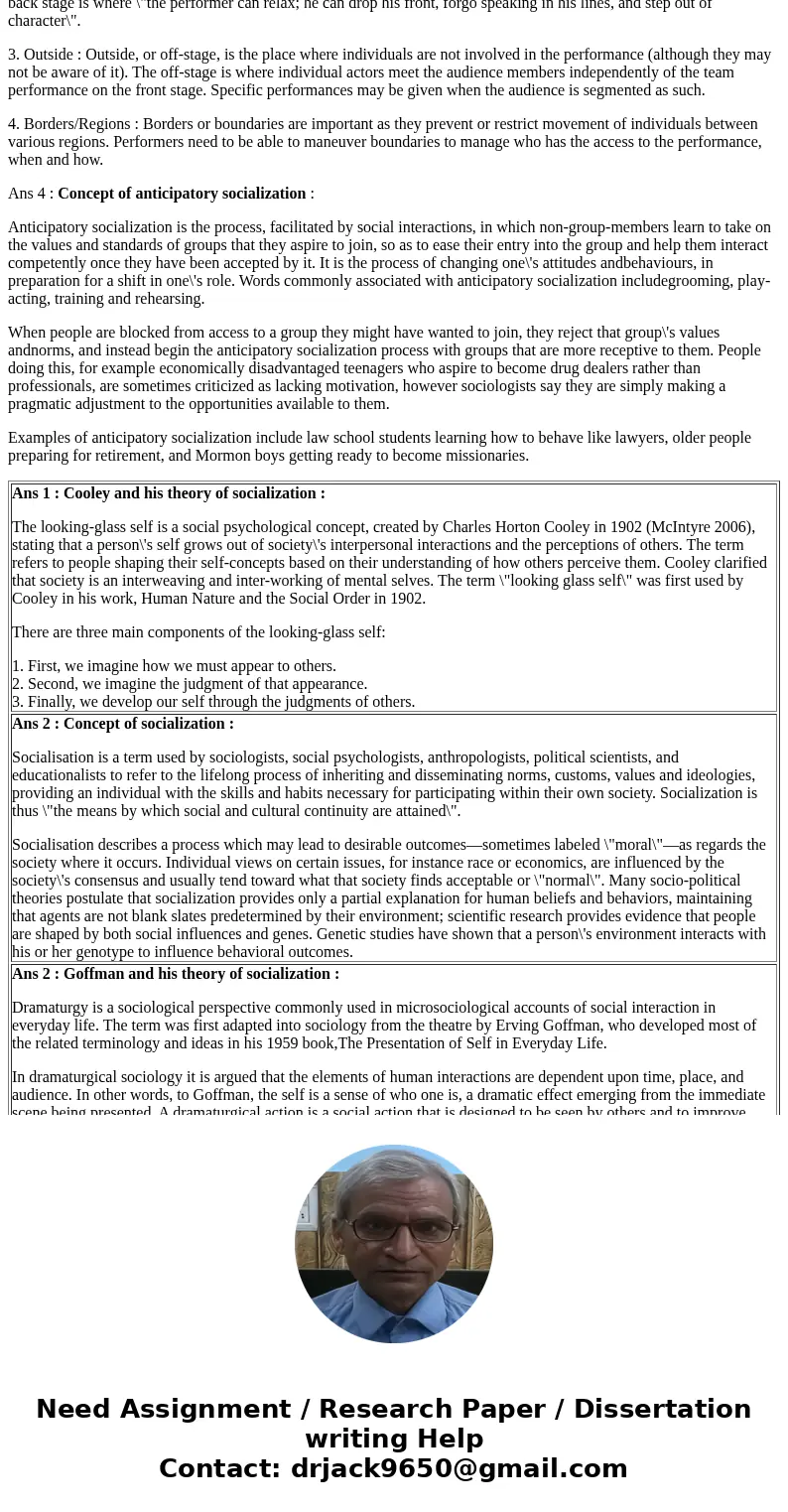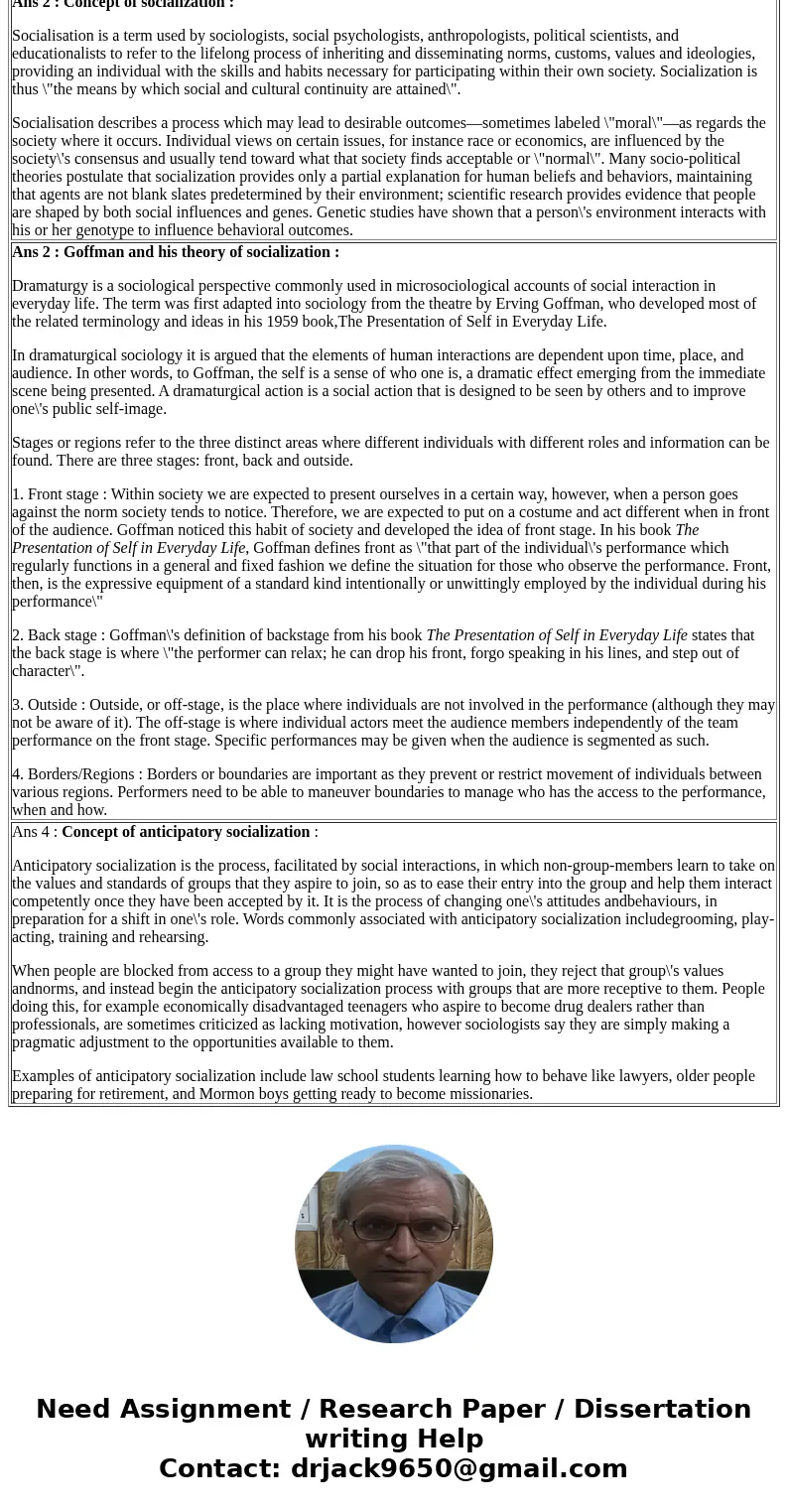1 Discuss Cooley and his theory of socialization 2Define th
1- Discuss Cooley and his theory of socialization ?
2-Define the concept of socialization in detail?
3- Discuss Goffman and his theory of socialization. Discuss four of the phrases he used in his analysis of social structure.such as front stage ,back stage impression management
4- Discuss the concept of anticipatory socialization and relate it to your life on campus ?
Solution
Ans 1 : Cooley and his theory of socialization :
The looking-glass self is a social psychological concept, created by Charles Horton Cooley in 1902 (McIntyre 2006), stating that a person\'s self grows out of society\'s interpersonal interactions and the perceptions of others. The term refers to people shaping their self-concepts based on their understanding of how others perceive them. Cooley clarified that society is an interweaving and inter-working of mental selves. The term \"looking glass self\" was first used by Cooley in his work, Human Nature and the Social Order in 1902.
There are three main components of the looking-glass self:
1. First, we imagine how we must appear to others.
2. Second, we imagine the judgment of that appearance.
3. Finally, we develop our self through the judgments of others.
Ans 2 : Concept of socialization :
Socialisation is a term used by sociologists, social psychologists, anthropologists, political scientists, and educationalists to refer to the lifelong process of inheriting and disseminating norms, customs, values and ideologies, providing an individual with the skills and habits necessary for participating within their own society. Socialization is thus \"the means by which social and cultural continuity are attained\".
Socialisation describes a process which may lead to desirable outcomes—sometimes labeled \"moral\"—as regards the society where it occurs. Individual views on certain issues, for instance race or economics, are influenced by the society\'s consensus and usually tend toward what that society finds acceptable or \"normal\". Many socio-political theories postulate that socialization provides only a partial explanation for human beliefs and behaviors, maintaining that agents are not blank slates predetermined by their environment; scientific research provides evidence that people are shaped by both social influences and genes. Genetic studies have shown that a person\'s environment interacts with his or her genotype to influence behavioral outcomes.
Ans 2 : Goffman and his theory of socialization :
Dramaturgy is a sociological perspective commonly used in microsociological accounts of social interaction in everyday life. The term was first adapted into sociology from the theatre by Erving Goffman, who developed most of the related terminology and ideas in his 1959 book,The Presentation of Self in Everyday Life.
In dramaturgical sociology it is argued that the elements of human interactions are dependent upon time, place, and audience. In other words, to Goffman, the self is a sense of who one is, a dramatic effect emerging from the immediate scene being presented. A dramaturgical action is a social action that is designed to be seen by others and to improve one\'s public self-image.
Stages or regions refer to the three distinct areas where different individuals with different roles and information can be found. There are three stages: front, back and outside.
1. Front stage : Within society we are expected to present ourselves in a certain way, however, when a person goes against the norm society tends to notice. Therefore, we are expected to put on a costume and act different when in front of the audience. Goffman noticed this habit of society and developed the idea of front stage. In his book The Presentation of Self in Everyday Life, Goffman defines front as \"that part of the individual\'s performance which regularly functions in a general and fixed fashion we define the situation for those who observe the performance. Front, then, is the expressive equipment of a standard kind intentionally or unwittingly employed by the individual during his performance\"
2. Back stage : Goffman\'s definition of backstage from his book The Presentation of Self in Everyday Life states that the back stage is where \"the performer can relax; he can drop his front, forgo speaking in his lines, and step out of character\".
3. Outside : Outside, or off-stage, is the place where individuals are not involved in the performance (although they may not be aware of it). The off-stage is where individual actors meet the audience members independently of the team performance on the front stage. Specific performances may be given when the audience is segmented as such.
4. Borders/Regions : Borders or boundaries are important as they prevent or restrict movement of individuals between various regions. Performers need to be able to maneuver boundaries to manage who has the access to the performance, when and how.
Ans 4 : Concept of anticipatory socialization :
Anticipatory socialization is the process, facilitated by social interactions, in which non-group-members learn to take on the values and standards of groups that they aspire to join, so as to ease their entry into the group and help them interact competently once they have been accepted by it. It is the process of changing one\'s attitudes andbehaviours, in preparation for a shift in one\'s role. Words commonly associated with anticipatory socialization includegrooming, play-acting, training and rehearsing.
When people are blocked from access to a group they might have wanted to join, they reject that group\'s values andnorms, and instead begin the anticipatory socialization process with groups that are more receptive to them. People doing this, for example economically disadvantaged teenagers who aspire to become drug dealers rather than professionals, are sometimes criticized as lacking motivation, however sociologists say they are simply making a pragmatic adjustment to the opportunities available to them.
Examples of anticipatory socialization include law school students learning how to behave like lawyers, older people preparing for retirement, and Mormon boys getting ready to become missionaries.
| Ans 1 : Cooley and his theory of socialization : The looking-glass self is a social psychological concept, created by Charles Horton Cooley in 1902 (McIntyre 2006), stating that a person\'s self grows out of society\'s interpersonal interactions and the perceptions of others. The term refers to people shaping their self-concepts based on their understanding of how others perceive them. Cooley clarified that society is an interweaving and inter-working of mental selves. The term \"looking glass self\" was first used by Cooley in his work, Human Nature and the Social Order in 1902. There are three main components of the looking-glass self: 1. First, we imagine how we must appear to others. |
| Ans 2 : Concept of socialization : Socialisation is a term used by sociologists, social psychologists, anthropologists, political scientists, and educationalists to refer to the lifelong process of inheriting and disseminating norms, customs, values and ideologies, providing an individual with the skills and habits necessary for participating within their own society. Socialization is thus \"the means by which social and cultural continuity are attained\". Socialisation describes a process which may lead to desirable outcomes—sometimes labeled \"moral\"—as regards the society where it occurs. Individual views on certain issues, for instance race or economics, are influenced by the society\'s consensus and usually tend toward what that society finds acceptable or \"normal\". Many socio-political theories postulate that socialization provides only a partial explanation for human beliefs and behaviors, maintaining that agents are not blank slates predetermined by their environment; scientific research provides evidence that people are shaped by both social influences and genes. Genetic studies have shown that a person\'s environment interacts with his or her genotype to influence behavioral outcomes. |
| Ans 2 : Goffman and his theory of socialization : Dramaturgy is a sociological perspective commonly used in microsociological accounts of social interaction in everyday life. The term was first adapted into sociology from the theatre by Erving Goffman, who developed most of the related terminology and ideas in his 1959 book,The Presentation of Self in Everyday Life. In dramaturgical sociology it is argued that the elements of human interactions are dependent upon time, place, and audience. In other words, to Goffman, the self is a sense of who one is, a dramatic effect emerging from the immediate scene being presented. A dramaturgical action is a social action that is designed to be seen by others and to improve one\'s public self-image. Stages or regions refer to the three distinct areas where different individuals with different roles and information can be found. There are three stages: front, back and outside. 1. Front stage : Within society we are expected to present ourselves in a certain way, however, when a person goes against the norm society tends to notice. Therefore, we are expected to put on a costume and act different when in front of the audience. Goffman noticed this habit of society and developed the idea of front stage. In his book The Presentation of Self in Everyday Life, Goffman defines front as \"that part of the individual\'s performance which regularly functions in a general and fixed fashion we define the situation for those who observe the performance. Front, then, is the expressive equipment of a standard kind intentionally or unwittingly employed by the individual during his performance\" 2. Back stage : Goffman\'s definition of backstage from his book The Presentation of Self in Everyday Life states that the back stage is where \"the performer can relax; he can drop his front, forgo speaking in his lines, and step out of character\". 3. Outside : Outside, or off-stage, is the place where individuals are not involved in the performance (although they may not be aware of it). The off-stage is where individual actors meet the audience members independently of the team performance on the front stage. Specific performances may be given when the audience is segmented as such. 4. Borders/Regions : Borders or boundaries are important as they prevent or restrict movement of individuals between various regions. Performers need to be able to maneuver boundaries to manage who has the access to the performance, when and how. |
| Ans 4 : Concept of anticipatory socialization : Anticipatory socialization is the process, facilitated by social interactions, in which non-group-members learn to take on the values and standards of groups that they aspire to join, so as to ease their entry into the group and help them interact competently once they have been accepted by it. It is the process of changing one\'s attitudes andbehaviours, in preparation for a shift in one\'s role. Words commonly associated with anticipatory socialization includegrooming, play-acting, training and rehearsing. When people are blocked from access to a group they might have wanted to join, they reject that group\'s values andnorms, and instead begin the anticipatory socialization process with groups that are more receptive to them. People doing this, for example economically disadvantaged teenagers who aspire to become drug dealers rather than professionals, are sometimes criticized as lacking motivation, however sociologists say they are simply making a pragmatic adjustment to the opportunities available to them. Examples of anticipatory socialization include law school students learning how to behave like lawyers, older people preparing for retirement, and Mormon boys getting ready to become missionaries. |



 Homework Sourse
Homework Sourse